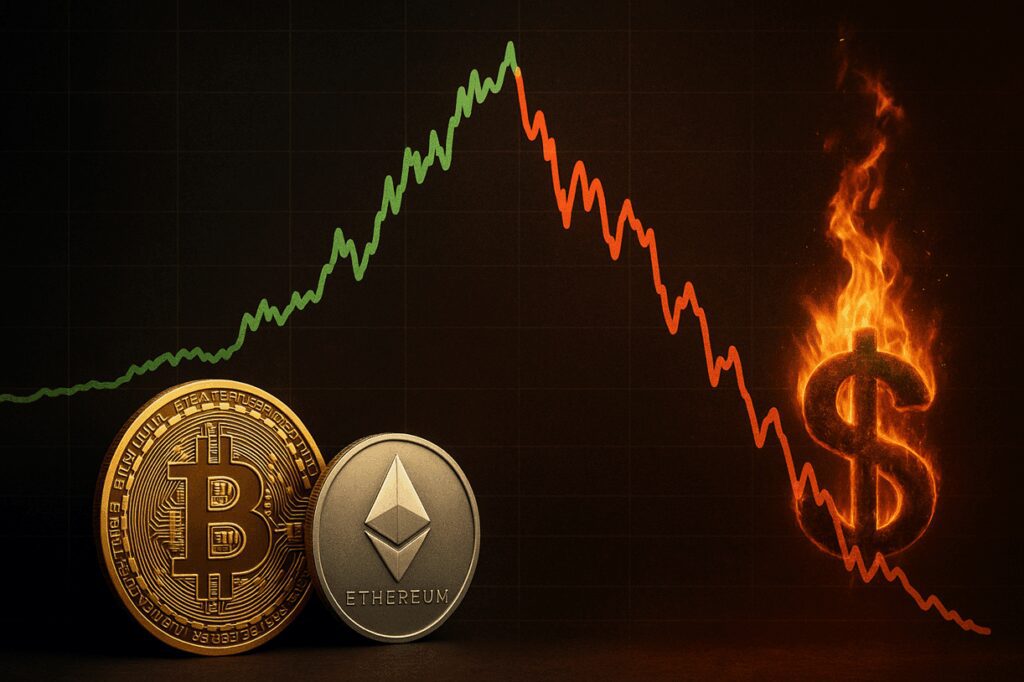cryptocurrency market We have just faced a new storm. On Monday, Bitcoin and Ethereum exchange-traded funds (ETFs) recorded a staggering $755 million in combined outflows, one of the largest single-day losses since the ETFs began trading. The decline comes on the heels of a weekend that wiped more than $500 billion off the valuation of global cryptocurrencies. Investors are clearly nervous and are adjusting their positions and waiting for the next macro signal before investing again.
What the heck happened to Bitcoin and Ethereum ETFs?
Spot Bitcoin and Ethereum exchange-traded funds (ETFs) in the US have had their worst day ever. More than $755 million in total outflows reached the market on Monday, the first trading day after a weekend of brutal liquidations that wiped out more than $500 billion from the global crypto market, according to SoSoValue data.

SoSoValue’s Ethereum Spot ETF Chart This reveals steep daily net outflows of $428.52 million as of October 13, highlighting the worst decline in institutional investor sentiment for ETH since the ETF debut. Despite holding $14.48 billion in cumulative net inflows, the day’s red wave was dominated by BlackRock’s ETHA fund, with $310 million in withdrawals, followed by outflows from Grayscale, Fidelity, and Bitwise.
No Ethereum ETFs reported inflows on the day. The total transaction amount reached $2.82 billion, and the total net assets amounted to $28.75 billion, accounting for 5.56% of Ethereum’s market capitalization. Interestingly, despite the surge in outflows, the ETH ETF has recorded significant daily price increases of over 6%, suggesting that market makers and arbitrage traders are likely repositioning after the weekend’s massive liquidations, rather than abandoning Ethereum completely.

Bitcoin Spot ETF Dashboard It paints a similar but more benign picture, with daily outflows of $326.52 million recorded on the same day, October 13th. This marks a cautious withdrawal phase following the weekend’s extreme volatility.
Still, the cumulative story remains strong. Bitcoin ETFs held a total of $62.44 billion in net inflows, indicating strong long-term confidence. Among issuers, BlackRock’s IBIT stood out with $60.36 million in new inflows, while Grayscale’s GBTC and Fidelity’s FBTC posted losses of $145.39 million and $93.28 million, respectively.
The total trading volume reached $6.63 billion, and the ETF’s total net assets were $157.18 billion, accounting for 6.81% of Bitcoin’s market capitalization. Although all major funds ended the day lower, the data shows that Bitcoin ETFs retain relatively strong institutional support compared to Ethereum, suggesting that risk-averse investors are selectively reducing their exposure to the cryptocurrency rather than exiting it completely.
Why are investors pulling out?
Analysts say this is not a cause for panic, but a need for vigilance. Vincent Liu, CIO, Kronos Research; explained It said Monday’s large ETF withdrawals reflected “post-liquidation caution.” In other words, investors are waiting for the weekend dust to settle down.
He added: “It’s clear that investors are pausing and waiting for clearer macro signals before putting more money into play. Sentiment is driving activity more than fundamentals right now.”
The weekend crash was triggered by US President Donald Trump confirms intention to impose 100% tariffs on imports from Chinaraising concerns about a renewed trade war. This single announcement caused crypto prices to fall by 10%, and a subsequent softening of President Trump’s tone allowed for a partial recovery.
Is this the start of a larger trend?
Probably not. Min Jeong, a researcher at Presto Research, said the rapid outflows likely reflected short-term institutional risk management rather than a sustained bearish trend.
“ETF flows will begin to stabilize as the market absorbs weekend volatility and broader macro uncertainty,” Jung said.
Still, the market is nervous. China’s new statement that it is “ready to fight to the end” in the trade conflict is already sending new shock waves. As of Tuesday, Bitcoin was down 2.54% to $112,283, and Ether was down 3.39% to $4,030, according to The Block.
What happens next?
The coming weeks will be all about macroeconomic signals. Any move by the US or China could sway sentiment overnight. ETF flows are likely to recover slowly rather than quickly, and traders are expected to remain cautious.
The important point here is that what just happened was not a collapse of faith, but a moment of collective restraint. After the largest liquidation in crypto history, big bucks are just catching their breath.



